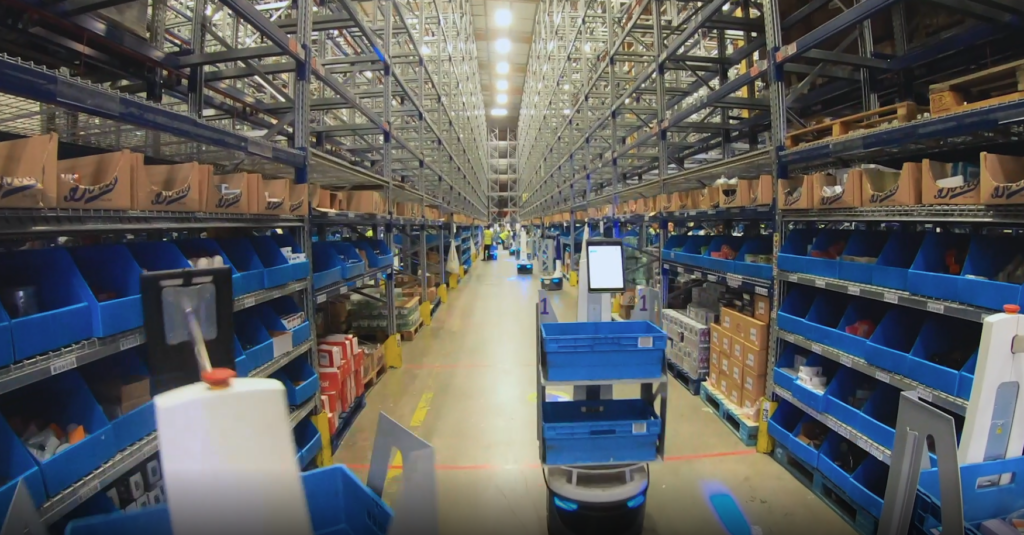Webinar Registration: The P2G Advantage
Webinar Registration: The P2G Advantage LEARN MORE
2022 Trends & Innovations in Warehouse Automation
Jason Walker, Vice President, Market Development

The COVID-19 pandemic made a major impact on supply chain operations, from manufacturing and shipping to distribution and warehousing. When the world shut down, warehouses were faced with a seemingly unsolvable question: How do we continue operating while keeping people home safe? The answer quickly revealed itself: automation.
Warehouse automation is not a new concept, and various automated systems have become commonplace around the world. However, a global pandemic has shown us new ways automation can help warehouses make major improvements and empower their workforce. As we continue to get used to a “new normal,” here are some emerging trends and innovations in warehouse automation that you should consider for your operation.
10 Trends & Innovations in Warehouse Automation
- Shuttle Automated Storage & Retrieval Systems
Otherwise known as a shuttle AS/RS, these automated storage and retrieval systems use multiple shuttles traveling in three dimensions to automatically pick and place loads from dedicated high density shelving racks in a warehouse with precision, accuracy, and speed, according to MHI. This automated storage solution saves workers time and strain when it comes to order fulfilment in a warehouse, and is a vital support system for critical warehouse functions such as:
- Picking
- Kitting
- Assembly
- And more
- Conveyor Solutions
The modern warehouse must be agile when it comes to layout, and that has given rise to automated and flexible conveyor systems. Traditional fixed conveyor systems meant warehouse layouts and workflows could never change, or if they did, they required long down-times and work stoppages. Advancements in flexible powered conveyors have given warehouses more options to automate material flow. And warehouses can take advantage of modern technologies like warehouse robots with conveyor top modules, to work with existing conveyor systems so workflows can grow and scale as production dictates.
- Pallet Transport Robots
Pallet transport can be one of the most time-consuming and physically demanding tasks in a warehouse environment. To improve efficiency and allow employees to work on more value-added tasks, many organizations are turning to pallet transport robots. These warehouse robots can locate and transport large payloads consistently throughout the day and even outside of work hours. The ideal pallet robot will have several attributes that make it easier to integrate into a warehouse operation, such as:
- Natural feature or SLAM navigation
- Dynamic path planning
- Omnidirectional navigation
- Autonomous charging
- Flexible top modules for loading and unloading materials
- Automated Carts
Warehouse workers know all too well the miles they can rack up pushing carts around the facility. But now, warehouse automation has made it possible to pass that task on to an automated or robotic cart, so workers can focus on tasks they enjoy and add value to the warehouse. Automated carts can be programmed to navigate between set points, collecting products and delivering them to storage, shipping, assembly, and more.
Often, these carts require guidance like lines on the floor and may be referred to as automated guided carts or AGCs. Other options available for warehouses involve fully autonomous mobile robots (AMRs) moving carts to destinations without the need for external guidance. The user simply programs a destination, and the AMR can find its own path. Multipurpose AMRs can even autonomously load and unload materials or connect to a variety of carts commonly utilized in warehouses.
- Collaborative Robots
Collaborative robots, or Cobots, are automated solutions that are designed to work alongside the human workforce, making the humans’ jobs easier by completing monotonous or physically demanding tasks. Sometimes these robots are integrated into an AMR to form a mobile manipulator that can be a force multiplier for cobot manipulation and AMR mobility. These robots help optimize warehouse operations while supporting people in their skilled work. Some of the initial benefits warehouses get from implementing cobots include:
- Improved safety
- Improved working conditions
- Enhanced flexibility
- Increased efficiency
- Increased throughput
- Autonomous Mobile Robots
As solutions become more flexible, cost effective, and easier to deploy, autonomous mobile robots (AMRs) are growing in popularity and potential uses in the warehouse environment. These robots are an improvement on AGVs in that they can navigate flexibly and autonomously using on-board sensors without additional infrastructure. Workers can use AMRs to transport goods without physical guides or markers, making setup, deployment, and operation a breeze.
- Scalability
If the global pandemic has given us one lesson, it’s that we need to be prepared for anything, and that is certainly true when it comes to warehouse and fulfillment activities. Automated warehouse solutions can improve many functions, but it can be frustrating if these tools and technology aren’t designed to adapt and grow as needed. Scalability — when it comes to warehouse automation, robots, and storage— means having solutions that are easily reconfigured, scaled up or down, and can be made to fit your operation, not the other way around. Flexible solutions like autonomous mobile robots enable companies to adapt warehouse operations as demand fluctuates, taking pressure off workers in the process.
- Automating the Picking Process
Picking is one of the most time-consuming and physically taxing tasks in warehouse operations — in fact, it accounts for 50% of the entire fulfillment process, eating up valuable time and money. With automated warehouse solutions, like cobots, automated forklifts and carts, autonomous mobile robots, and mobile conveyors, the picking process can be almost entirely automated. With these solutions, workers can spend less time on the picking process and more time handling other tasks that are more complex and valuable to the entire warehouse.
- Automated Cleaning Machines
The COVID-19 pandemic made warehouse cleaning and sanitation a top priority. To make cleaning a continuous and safe process, many warehouses have turned to automated cleaning robots. Autonomous cleaning machines can handle floor cleaning, air purification and more, ensuring that warehouses stay as clean as possible without exposing workers to any pathogens or harmful cleaning chemicals.
- Industrial IoT
Industrial Internet of Things (IIoT), also known as industry 4.0, is seeing industrial settings, like warehouses, leverage the latest technologies to optimize efficiency. To do that, many warehouses are implementing advanced sensor technology that helps them connect and monitor the various functions of their operations. This connectedness gives warehouses new data to inform the decision-making that will optimize and improve every facet of their process.
Warehouse Automation Best Practices
- Optimize Automation Around the Workforce
No matter how many cutting-edge technologies or optimized systems a warehouse implements, the solution is only as good as the people they have working there. Automation should be used to support the workforce — to effectively do that, you need to first identify the existing processes and areas that need improvement and focus automation on those functions. Workers will be best at pinpointing inefficient and wasteful functions that could be improved with automation, which in turn will free them up for important work responsibilities and tasks.
- Create Well-Defined Processes Around Automated Systems
End user adoption is critical to the success of any new tool or technology, and that is certainly the case with warehouse automation. To ensure that implementation goes smoothly, it is important to have well-defined processes around these new automated solutions and to involve workers’ input when creating these procedures. Not only will that make it easier on employees when they must interact with the automated technology, it will also ensure that the equipment is being used properly, and that the new process improves the workers' efficiency.
- Emphasize Effective Warehouse Layout Design
An important part of evaluating processes is to review your warehouse layout. Are things laid out in a way that makes sense for the workflows? Or are materials and equipment scattered about? By taking a fresh look at the big picture, you may be able to adjust your warehouse layout that will reduce distances between point A and point B and make the automation much more effective, which will make your warehouse more efficient.
- Find flexible automation solutions
Warehouse automation technology has come too far for you to get stuck with a solution that dictates your operations. Today’s warehouse technology is flexible, scalable, can handle multiple tasks, and is supported by consistent innovation, so it will always be getting better. To make your investment worthwhile, e automated solutions that can work with your existing equipment and other automated solutions, so your operation can always be made to work the way you need it to.
- Automate only where it makes sense
Lastly, don’t just automate for the sake of automating — only implement new solutions in areas that make sense or demand a faster option. Many automated warehouse solutions are built to grow with you, with additional equipment or add-ons available down the road. It can be hard to know exactly what you need for your warehouse operation, but there is good news: Locus Robotics can help you improve your current operations and make recommendations to get you to your warehouse optimization goals with our full fleet of AMRs. Let’s talk and take the first step towards your warehouse automation.
About the Author
Jason has over 20 years of robotics leadership roles that range from managing QA and testing for iRobot’s Roomba to co-founding CyPhy Works, a revolutionary tethered drone company. Most recently, Jason was Co-founder and CEO of Waypoint Robotics, a leading provider of heavy payload capacity, omnidirectional AMRs, that was acquired by Locus in 2021. Jason is a life-long roboticist and has won many awards, accolades, and patents for various robot-related technologies. Jason is using his vast knowledge and experience to propel Locus into new opportunities.




